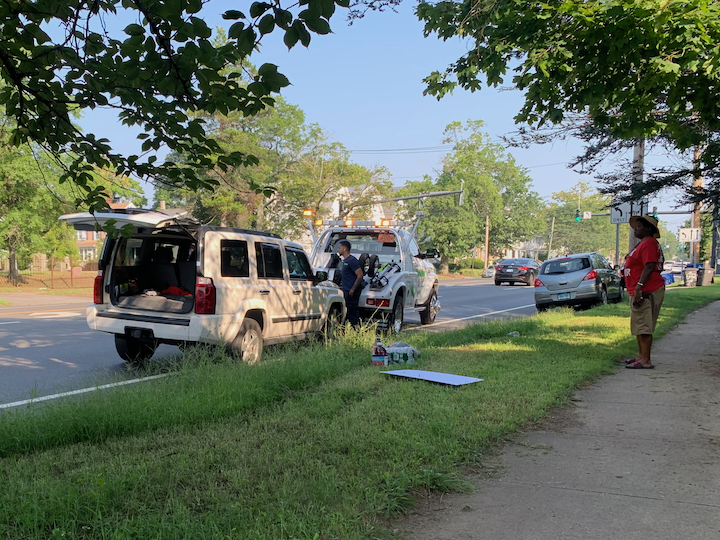
Maya McFadden Photos
Officers Richard Burgos, Jason Jackson, and Christian Carfora in action at Whalley & West Park.
As he zoomed down Whalley Avenue, Hunter thought about arriving on time to his new job six blocks away at A‑1 Oriental Kitchen. He thought about sending his daughter to college this weekend. He wasn’t thinking about the speed limit.
A team of officers from the New Haven Police Department Traffic Enforcement Unit were thinking about the speed limit. And making sure people follow it.
The officers pulled Hunter over and informed him he had exceeded the limit by at least 20 miles per hour.
“I thought I was just going with the flow,” Hunter said.
Hunter, who is 59, received a ticket for “traveling unreasonably fast.” The fine: $191.
Hunter said he had a lot on his mind: He has two kids and a wife who can’t work. In 2017 he was laid off from his full-time job. He has been working part-time jobs since then to put his daughter through her second year of college and taking care of his wife and a son who has autism.
“I respect why they did it. I just wish my punishment wasn’t hitting my pockets,” he said after the officers ticketed him.
“It’s crazy, but now I know.”

Officers Burgos, Jackson, and Carfora.

A glimpse into the job.
Hunter was one of 31 speeders stopped and ticketed over three hours Thursday afternoon. They weren’t just slight speeders; they were “egregious speeders,” traveling as high as 57 miles per hour. The NHPD is running extra shifts like these at speedways around town through Sept. 6 thanks to a $50,000 Connecticut Department of Transportation Speed and Aggressive Driving Enforcement Grant.
Officers Christian Carfora, Jason Jackson, and Richard Burgos were on duty for Thursday’s shift on Whalley. There was no shortage of dangerous drivers as the officers stood at the corner of West Park Avenue with a set of binocular-like laser speed checkers. The devices the officers used can catch drivers’ speeds from more than 1,000 feet away, said Jackson.
The speed limit is 25 miles per hour. The officers Thursday looked for “egregious speeding” of at least 40 miles per hour.
“There’s a difference between driving with the flow of traffic that’s at 30 or 35 and driving 50 on a commercial road,” said Jackson.

The officers found drivers violating rules other than just the speed limit. One driver wasn’t wearing a seat belt, and didn’t have his two kids, one under 2 and the other under 8, properly strapped into their car seats. The driver was stopped for going 54 miles per hour. He left with a $477 ticket for the multiple safety infractions.
When pointed at a car, the officers’ calibrated speed checkers either beeped to indicate a driver driving at the speed limit or dinged to indicate speeding. The officers focused up close on a car and, with the click of a button up top, captured the speed.

Once a speeder was spotted, the officers stepped into the road cautiously and flagged the driver down to pull over at the corner. Once the driver pulled over. the officers usually started with conversation with: “We’re traffic enforcement. You were going [said speed] in a 25.” Then they gathered the driver’s license and registration.
A few keyboard clicks later, a case number was assigned to each traffic stop, and the officers searched motor vehicle and identification records.
An inbound 25 mile-per-hour speed limit marker stands less than a block from where the officers were positioned on the corner. Jackson “hit” cars with the speed checker just as they “reached the crest of the hill” with the sign in sight.

After stopping one 54 mile-per-hour driver, Burgos had to call for the car to get towed. The driver had no car insurance or registration. There was also a misuse of license plates.

Many of the drivers were not as calm or ready to talk about their stops as Hunter was. If the stepped-up patrol succeeded in its mission, they will have learned a lesson.

Paul Bass Photo
Officers Jason Jackson, Oscar Diaz and Richard Burgos with supervisor Lt. Stephan Torquati last week at roll-out of special patrols.